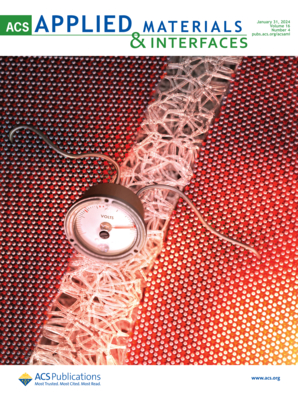利用 DNA-PAINT 揭示高密度生物功能化表面的空间分子异质性
IF 8.3
2区 材料科学
Q1 MATERIALS SCIENCE, MULTIDISCIPLINARY
引用次数: 0
摘要
量化和控制生物功能化表面上的分子密度和分布是实现生物科学可重现功能的关键。在这里,我们介绍了一种在短时间内量化高密度生物功能化表面的密度和空间分布的分析方法,其密度约为每 μm2 面积 102-105 个生物分子。该方法以单分子 DNA-PAINT 成像为基础,结合补偿寿命和空间采样不足效应的模拟模型,产生了三种不同的分子计数方法和空间分布统计测试。该分析方法以表面的 ssDNA 亲和粘合剂分子与 PLL-g-PEG 防污涂层耦合为例进行说明。分析结果有助于深入了解生物功能化的效率、产量和均匀性。此外,数据还揭示了生物功能化过程中固有的异质性,并揭示了潜在的分子机制。我们预计,DNA-PAINT 成像与所开发的分析框架将成为研究高密度生物功能化表面空间异质性的多功能工具,应用范围十分广泛。本文章由计算机程序翻译,如有差异,请以英文原文为准。

Revealing Spatial Molecular Heterogeneity of High-Density Biofunctionalized Surfaces Using DNA-PAINT
The quantification and control of molecular densities and distributions on biofunctionalized surfaces are key for enabling reproducible functions in biosciences. Here, we describe an analysis methodology for quantifying the density and spatial distribution of high-density biofunctionalized surfaces, with densities in the order of 102–105 biomolecules per μm2 area, in a short measurement time. The methodology is based on single-molecule DNA-PAINT imaging combined with simulation models that compensate for lifetime and spatial undersampling effects, resulting in three distinct molecule counting methods and a statistical test for spatial distribution. The analysis methodology is exemplified for a surface with ssDNA affinity binder molecules coupled to a PLL-g-PEG antifouling coating. The results provide insights into the biofunctionalization efficiency, yield, and homogeneity. Furthermore, the data reveal that heterogeneity is inherent to the biofunctionalization process and shed light on the underlying molecular mechanisms. We envision that DNA-PAINT imaging with the developed analysis framework will become a versatile tool to study spatial heterogeneity of densely biofunctionalized surfaces for a wide range of applications.
求助全文
通过发布文献求助,成功后即可免费获取论文全文。
去求助
来源期刊

ACS Applied Materials & Interfaces
工程技术-材料科学:综合
CiteScore
16.00
自引率
6.30%
发文量
4978
审稿时长
1.8 months
期刊介绍:
ACS Applied Materials & Interfaces is a leading interdisciplinary journal that brings together chemists, engineers, physicists, and biologists to explore the development and utilization of newly-discovered materials and interfacial processes for specific applications. Our journal has experienced remarkable growth since its establishment in 2009, both in terms of the number of articles published and the impact of the research showcased. We are proud to foster a truly global community, with the majority of published articles originating from outside the United States, reflecting the rapid growth of applied research worldwide.
 求助内容:
求助内容: 应助结果提醒方式:
应助结果提醒方式:


